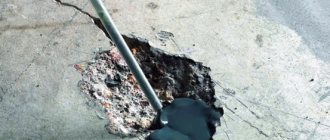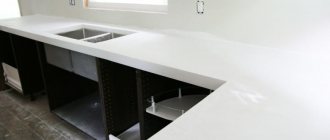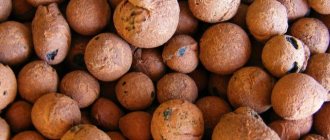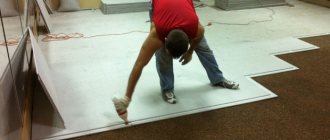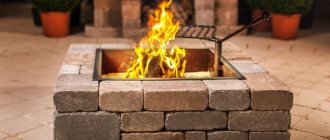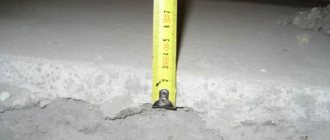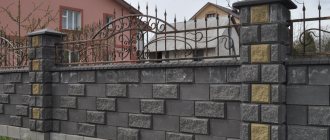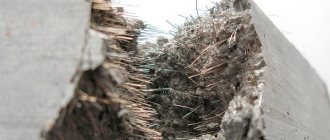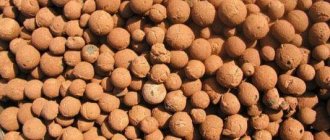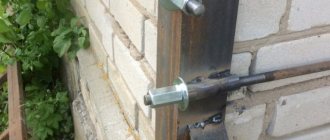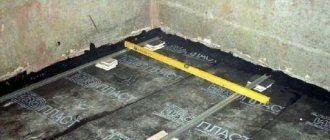To lay any type of flooring, you need to create a level base; most often, a concrete screed is installed for this. But there are situations when a concrete screed is not suitable for creating and leveling the base due to its heavy weight. Then the usual screed is replaced by modern technology for constructing a foundation - a lightweight floor.
There are two ways to create a light floor:
- Use special lightweight mixtures.
- Lighten the concrete screed with special fillers.
Mixture "Vetonit Light Floor"
Modern technologies do not stand still, and the same can be said for construction. In recent years, the “Vetonit Light Floor” mixture has become popular, which is widely used for constructing lightweight floors.
Vetonit is a lightweight mixture created on the basis of cement and expanded clay gravel, which is easy to install. It can be applied to both concrete and wooden bases. Vetonit has a number of advantages that make it excellent for both repairing floors and creating new subfloors. The most important advantage of Vetonit is its rapid setting and short period of complete drying, which allows you to move on to laying the finishing coating in a shorter time than cement-sand screed. In addition, Vetonit is well suited in cases where, due to large unevenness in the base of the floor, it is necessary to apply a thick layer of the mixture, and the structure cannot be made heavier. The “Vetonit Light Floor” mixture has a much lower density than concrete; for the first it is 700-900 kilograms per cubic meter, and for the second it is 2400 kilograms per cubic meter.
The Vetonit Light Floor mixture is used to level floors and seal large uneven surfaces. Vetonit is well suited for use in flooring in public and residential areas. In addition, this mixture is well suited for creating artificial uneven surfaces, for example in a bathroom.
To install a floor using the Vetonit Light Floor mixture, several conditions must be met:
- The room where the work is carried out must have a roof; Vetonit cannot be used outdoors.
- When performing work, the room temperature should not be lower than +10 degrees; the same requirements apply to the base of the floor.
- The humidity of the base on which the mixture is applied must be at least 90%. This is necessary to ensure that the entire floor structure dries evenly.
Vetonit mixture is available in 12.5 kilogram bags. To prepare the solution, you need to add 3 or 3.5 liters of water to this amount of the mixture. You should not add more water, as its excess will weaken the structure and slow down the drying process.
To prepare the solution, use only clean containers, water and tools. To install floors in large rooms, Vetonit solution is mixed in a concrete mixer; for work in small rooms, the solution is prepared in a spacious container and mixed with a powerful drill with an attachment or a construction mixer. When using Vetonit, it is worth remembering that after preparing the solution, it must be used within the next 30 minutes. It is worth noting that the layer thickness should not be less than 30 millimeters.
Vetonit solution consumption is 8 kilograms of dry mixture per square meter, provided that the layer thickness is about one centimeter.
To work with Vetonit, the master will need the following tools:
- Long rule (for applying the mixture to the base and leveling).
- Wooden or steel spatula (to level the mixture).
What is perlite in plaster and why is it added?
Perlite plaster is classified as a special composition - it is used to simultaneously finish and insulate walls. The mixture is porous, which reduces heat conductivity. The binding component is cement, lime, gypsum or a combination thereof. Perlite is of natural origin, so compositions based on it are safe for health.
- Features and properties of the material
- Scope of application
- Types of perlite plaster
- Cement based
- Gypsum based
- Selection criteria for external and internal work
- Making your own mixture
- Recommendations for application
- Surface preparation
- Calculation of the amount of solution
- Application technology
- Errors when working with material
Vetonit drying time
As mentioned above, the main advantage of Vetonit is its short drying period. If the room temperature is kept at least +20 degrees, then you can walk on the leveled surface with Vetonit within 12 hours after finishing the work. After another 12 hours, the surface can be cleaned and sanded if necessary.
Before the final leveling of the surface can begin, the humidity of the base should not exceed 90%. And it will be possible to begin the next stages of floor installation only after a few weeks; the specific time depends on the thickness of the Vetonite layer. The approximate drying time for the mixture is 1 week for every 5 centimeters of layer.
Before you begin laying the floor covering on a base made from the Vetonit Light Floor mixture, you must additionally level the surface. For the initial leveling of a concrete base, it is better to use the Vetonit 5000 or Vetonit Vaateri Plus mixture; for leveling the base in small rooms, the Vetonit 4000 Quick-drying mixture is well suited. Floor coverings such as carpet, parquet, and ceramic tiles can be laid on a surface leveled in this way.
To lay other types of flooring, such as vinyl tiles or PVC, the base must be leveled with Vetonit 3000 mixture. If you initially leveled the surface with Vaateri Plus, Vaateri Renovation or Vetonit 4000 mixtures, then it does not require additional leveling.
It is worth remembering that the surface leveled using these mixtures cannot be left without a floor covering or painted.
The leveling mixture “Vetonit Light Floor” is very easy to use; splashes that fall on the wall or other objects are easily washed off with water. If the unnecessary mixture has already hardened, it can be cleaned off mechanically using a spatula or any other convenient tool. All tools used in work must be washed immediately after completion.
Main technical characteristics of the Vetonit Light Floor mixture:
- The combined mixture with water must be used within 30 minutes.
- The temperature at the work site is at least +10 degrees, preferably +15 - +20 degrees.
- Recommended layer thickness is from 30 to 300 millimeters.
- The color of the mixture is grey.
- The weight of the bag is 12.5 kilograms.
- The shelf life of the dry mixture is 6 months.
- Composition: cement, crushed expanded clay gravel with a fraction size of 8 millimeters.
- Brand compressive strength is 3-5 MPa.
- Water consumption per bag of dry mixture (12.5 kilograms) is from 3 to 3.5 liters.
- The density of the dry mixture is from 700 to 900 kilograms per cubic meter.
- The temperature of the water used is no more than +35 degrees.
- The mixture consumption is 8 kilograms per square meter, provided that the layer thickness is one centimeter.
- Mixing time of the solution is at least two minutes.
- You can walk on the base after 12 hours.
Advantages of the Vetonit Light Floor mixture:
- Good sound insulation.
- Good thermal insulation.
- High level of strength.
- Low shrinkage (0.5 millimeters per meter).
- Low consumption - 8 kilograms per square meter.
- Suitable for insulating flat roofs.
- The possible layer thickness is from 30 to 300 millimeters.
- Reduces the load on the load-bearing base of the room.
General recommendations
High-quality self-leveling floor.
Experienced builders advise:
- in the room where the foundation will be poured there should be no drafts, moisture and temperatures below +15 for about two weeks;
- Do not try to mix dry powder with water by hand, be sure to use a drill;
- It is not advisable to paint the self-leveling surface or leave it uncoated for a long time, so after grinding the surface is covered.
Mixture "Osnovit Innoline T-43"
Light screed mixture "Osnovit Innoline T-43" is a heat-sound-insulating, highly efficient, high-strength and fairly economical material made on the basis of cement and expanded clay gravel. It is used for installing lightweight screeds in residential and commercial premises. The Osnovit Innoline T-43 mixture can significantly increase the sound insulation of the floor and thermal insulation properties, in addition, the base made from such a mixture can withstand high loads.
“Osnovit Innoline T-43” is suitable for leveling large uneven areas; this mixture can be used to lay screeds with a thickness of 30 to 300 millimeters. The mixture is easy to use, sets and dries quickly. It is suitable for repairing old foundations and creating new ones.
The leveling mixture "Osnovit Innoline T-43" has a low specific gravity, which greatly reduces the load on the load-bearing structures of the building and the passing communications in the room, for example, installation pipes, electrical wires, plumbing pipes, the design of warm water and electric floors, etc.
The lightweight Osnovit Innoline T-43 screed is also used for insulating flat roofs, as it has a high level of thermal insulation.
One of the advantages of the Osnovit Innoline T-43 mixture is that thanks to it, you can create a light screed using only one material and in one approach, in contrast to the traditional screed, when expanded clay is laid first, then the reinforcing mesh, and only then This is where the screed itself is poured. This advantage significantly reduces labor costs and installation time of the floor. A lightweight screed made from the Osnovit Innoline T-43 mixture is well suited for laying floor coverings such as parquet, solid wood, parquet boards, laminate, tiles, etc.
The Osnovit Innoline T-43 mixture is simple and easy to work with, it is plastic and can be leveled well over the base. After the solution sets, a smooth and durable surface is created. In addition, the base from this mixture does not contain harmful impurities, so it does not affect human health in any way and complies with all hygienic standards accepted in Russia. "Osnovit Innoline T-43" is a waterproof material and resistant to high frosts.
Main technical characteristics of the mixture “Osnovit Innoline T-43”:
- It is necessary to use the prepared solution within 30 minutes.
- The strength of adhesion to the base is about 0.6 MPa.
- The mixture consumption is from 10 to 12 kilograms per square meter, provided that the layer thickness is one centimeter.
- The temperature at the work site is from 5 to 30 degrees Celsius.
- Water consumption per kilogram of dry mixture is from 0.32 to 0.36 liters.
- Possible layer thickness is from 30 to 300 millimeters.
- The shelf life of the mixture is 6 months.
- The weight of the bag is 30 kilograms.
- Brand compressive strength 15 15 MPa.
- You can walk on the screed after 24 hours.
Advantages of the mixture “Osnovit Innoline T-43”:
- Good sound insulation.
- Good thermal insulation.
- High level of strength.
- There is no shrinkage.
- Low consumption - from 10 to 12 kilograms per square meter.
- Suitable for insulating flat roofs.
- The possible layer thickness is from 30 to 300 millimeters.
- Frost resistance.
- Reduces the load on the load-bearing base of the room.
- High level of moisture resistance.
- Suitable for both interior and exterior work.
Preparation of the mixture "Osnovit Innoline T-43"
To prepare a solution for installing a light screed, the dry mixture “Osnovit Innoline T-43” must be poured into a container with water at the rate of one kilogram of the mixture per 0.32 -0.36 liters of water. This is important - the mixture is added to the water, and not vice versa. One bag (30 kilograms) will require from 9.6 to 10.8 liters of water. The solution must be stirred for at least 5 minutes. This can be done either mechanically using a construction mixer or an electric drill with an attachment, or manually. It is necessary to mix the solution until a homogeneous mass is formed, which should resemble granular cottage cheese. After the first mixing, the mixture must be kept for 3-5 minutes, after which the solution must be mixed again for 2-3 minutes. After this, the mixture is ready for use.
The prepared mixture must be laid in the next 30-40 minutes. It is necessary to strictly observe the ratio of the mixture and water, since an excess of moisture will make the screed less durable, susceptible to delamination and cracks.
To prepare the solution, use only clean containers, water and tools.
Stages of screeding
During the entire preparation period they work with a level gauge
and beacons.
The beacons are installed in increments of 1.5 m in parallel, one to one, and verified with the level . The result depends on the correct placement.
The first beacon is placed at a distance of 20-30 cm from the wall surface. The second and subsequent ones are installed at a specified distance from the first, but must coincide with it in height.
The height is formed and verified with a level gauge . For this purpose, there are also plane builders or plane builders, but this equipment is professional. At home you can get by with a spirit level.
Heated floor screed
The mixture, which is already ready for use, is poured between the beacons, leveled and distributed according to building regulations (this is a metal tool for construction, made in different sizes and used for leveling surfaces covered with plaster). The solution itself is poured slightly above the level of the beacons.
After the work is completed with the cement-perlite screed, inspect the surface for cracks and check the level
.
The screed
will dry out in 25-28 days (watering is required 2 times a day to eliminate cracking). After drying, check the floor by tapping. A loud sound indicates that the screed is well fastened; a dull sound means that the face layer has separated.
Perlite sand for mixing
floor screed is an excellent choice. It is used almost everywhere in construction, it allows you to level the floor, improve its hydro- and thermal insulation characteristics and prepare the surface for laying the final material.
Dry screed, Technological process for making a concrete floor
Application of the mixture “Osnovit Innoline T-43”
When applying a solution made from the Osnovit Innoline T-43 mixture, the temperature of the base should not be lower than +5 degrees; the same requirements apply to the room in which the work is carried out.
The Osnovit Innoline T-43 solution must be evenly applied to the prepared base until the required thickness of the screed is achieved. After this, the applied solution must be leveled using a long rule, compacted a little and after 5-10 minutes rub the solution using a grater or spatula until a flat surface is achieved.
Ceramic tiles, all types of parquet, laminate can be laid directly on a screed made from the Osnovit Innoline T-43 mixture. To lay other floor coverings, for example, linoleum and other thin materials, an additional layer of self-leveling flooring, about 5 millimeters thick, must be applied to the screed. To do this, you can use the Osnovit Nipline T-42 mixture. Screed made from the Osnovit Innoline T-43 mixture cannot be used without a floor covering.
It will be possible to walk on a screed made from the Osnovit Innoline T-43 mixture within 24 hours. 7 days after laying the screed, gentle loading can be applied to it. The final strength of the screed is achieved after 28 days.
Consumption rates and prices for dry floor fillers
| Type of backfill | Fraction, mm | Layer thickness, cm | Consumption, kg/m 2 with a layer thickness of 10 cm | price, rub. |
| Expanded clay | 5–10 | 1030 | 25–4575–135 | from 85/50kg |
| 10–20 | ||||
| 20–40 | ||||
| Vermiculite | M100 | 10–20 | 10 | from 5200/1 m 3 (100 kg) |
| Perlite | M75, M100 | 10–20 | 7,5–10,0 | from 3680/1 m 3 (75 kg) |
| Compavit | 4–5 | 10–30 | 50–60 | 105–120/40 l bag |
